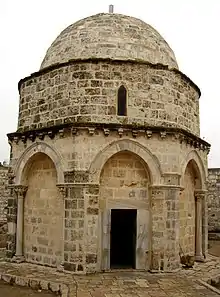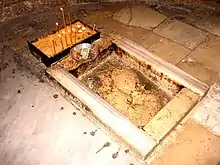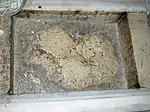Church of the Ascension, Jerusalem
The Church of the Ascension (Hebrew: קפלת העלייה Qapelat ha-ʿAliyya, Greek: Εκκλησάκι της Αναλήψεως, Ekklisáki tis Analípseos, Arabic: كنيسة الصعود) is a shrine located on the Mount of Olives, in the At-Tur district of Jerusalem. Part of a larger complex consisting first of a Christian church and monastery, then an Islamic mosque, it is located on a site the faithful traditionally believed to be the earthly spot where Jesus ascended into Heaven after His Resurrection. It houses a slab of stone believed to contain one of His footprints. The Status Quo, a 250-year-old understanding between religious communities, applies to the site.[1][2]
| Church of the Ascension | |
|---|---|
 The Ascension Ædicule | |
| Religion | |
| Affiliation | Christian, Islamic |
| District | At-Tur |
| Ecclesiastical or organizational status | Under Islamic jurisdiction |
| Location | |
| Location | At-Tur, Mount of Olives, Jerusalem, Palestine |
| Architecture | |
| Style | Romanesque |
| Completed | First church c. 390; current chapel: c. 1150 |
History
Origin and traditions
Shortly after the death and resurrection of Jesus, early Christians began gathering in secret to commemorate His Ascension at a small cave-church on the Mount of Olives.[3] The issuance of the Edict of Milan by the Roman Emperor Constantine I in 313 made it possible for Christians to worship overtly without fear of government persecution. By the time of the pilgrim Egeria's travels to Jerusalem in 384, the spot of veneration had been moved to the present location, uphill from the cave,[3] which had been integrated into the Constantinian Church of Eleona, dedicated by then just to Jesus' teachings about good and evil (Matthew 24:1-26:2).[4] Egeria witnessed the celebration of the Ascension at an "open hillock" near the cave.[5] The first church was erected there a few years later, sometime before 392, by a lady from the imperial family, Poimenia.[5] Later a legend attributed the church to Saint Helena, mother of Constantine I.[6] The legend holds that during Saint Helena's pilgrimage to the Holy Land between 326 and 328, she identified two spots on the Mount of Olives as being associated with Jesus' life - the place of His Ascension, and a grotto associated with His teaching of the Lord's Prayer - and that on her return to Rome she ordered the construction of two sanctuaries at these locations.
4th century church
The first complex constructed on the site of the present chapel was known as Imbomon (Greek for "on the hill"). It was a rotunda, open to the sky, surrounded by circular porticoes and arches. Sometime between AD 384–390, Poimenia, a wealthy and pious Roman aristocratic woman of the imperial family financed the building of a Byzantine-style church "around Christ's last footprints".[6]
The Imbomon, as well as the nearby Eleona Basilica and other monasteries and churches on the Mount of Olives, were destroyed by the armies of the Persian Shah Khosrau II during the final phase of the Byzantine-Sassanid Wars in 614.
7th century church
It was subsequently rebuilt in the late 7th century. The Frankish bishop and pilgrim Arculf, in relating his pilgrimage to Jerusalem in about the year 680, described this church as "a round building open to the sky, with three porticoes entered from the south. Eight lamps shone brightly at night through windows facing Jerusalem. Inside was a central edicule containing the footprints of Christ, plainly and clearly impressed in the dust, inside a railing."[7]
12th century church
The reconstructed church was eventually destroyed, and rebuilt a second time by the Crusaders in the 12th-century. This final church was eventually destroyed by the armies of Salah ad-Din, leaving only a partially intact outer 12x12 meter octagonal wall surrounding an inner 3x3 meter shrine, also octagonal, called a martyrium or edicule. This structure still stands today,[7] in a form partially altered in the time after Saladin's 1187 conquest of Jerusalem.
Muslim changes since 1187
After the fall of Jerusalem in 1187 the ruined church and monastery were abandoned by the Christians, who resettled in Acre. During this time Salah ad-Din established the Mount of Olives as a waqf entrusted to two sheikhs, al-Salih Wali al-Din and Abu Hasan al-Hakari. This Waqf (Islamic trust) was registered in a document dated 20 October 1188.[8] The chapel was converted to a mosque, and a mihrab installed in it. Because the vast majority of pilgrims to the site were Christian, as a gesture of compromise and goodwill Salah ad-Din ordered the construction, two years later, of a second mosque nearby for Muslim worship while Christians continued to visit the main chapel. Also around this time the complex was fortified with towers, walls, and guarded by watchman.[9] The shrine and surrounding structures saw periods of non-use and disrepair over the next 300 years. By the 15th century the destroyed eastern section of the octagonal outer wall was separated from the rest by a dividing wall and was occupied by peasant houses and animal stables.[10] Though still under the authority of the Islamic Waqf of Jerusalem, the edicule-turned-mosque is currently opened to visitors of all faiths, for a nominal fee.[11]
Description of the chapel
Edicule (chapel)
The main structure of the chapel is from the Crusader era; the stone dome and the octagonal drum it stands on are Muslim additions. The exterior walls are decorated with arches and marble columns. The entrance is from the west, the interior of the chapel consists of a mihrab indicating the direction of Mecca in the south wall. On the floor, inside a stone frame, is a slab of stone called the "Ascension Rock".[12]
Ascension rock
The octagonal ædicule surrounds the Ascension rock, said to contain the right footprint of Christ, the section bearing the left footprint having been taken to the Al-Aqsa Mosque in the Middle Ages. The faithful believe that the impression was made as Jesus ascended into Heaven and is venerated as the last point on earth touched by the incarnate Christ.
Arculf writes about "the footprints of Christ, plainly and clearly impressed in the dust", which he saw in ca. 680 CE (see above).
The zawiya of Rabi'a al-'Adawiyya
Analysis of the building
The mosque that stands southwest of the former Church of the Ascension, known as the zawiya of Rabi'a al-'Adawiyya, consists of two edifices: the upper one, or the mosque proper; and at the lower end of a staircase connecting the two structures, an underground chamber or burial cave, which includes a 2 m deep, 1.2 m wide and 1.8 m high cell on its east side.[13] Archaeologists Jon Seligman and Rafa Abu Raya, who have carried out a short salvage excavation outside the southern wall of the mosque in 1995, have dated the underground chamber to the Byzantine period, identifying it as the crypt of a chapel that was part of the complex of the Church of the Ascension.[14]
On the southern wall and near the tomb, a Greek funeral inscription of the Byzantine period mentioning the name Domitilla probably indicates who the tomb belonged to, even though the belief that it held the remains of Saint Pelagia is also attested from the Byzantine period.[14]
Seligman and Abu Raya date the upper building to the medieval period, and hold an Ayyubid date to be the most likely, not excluding a Crusader date until further research is done.[14] However, Denys Pringle suggests a Crusader date, based on features such as the western entrance which could indicate an east–west orientation of the structure, and the fact that the mihrab is set into an older window niche.[13]
Christian, Jewish and Muslim traditions
The burial crypt is revered by three separate monotheistic religions, although opinion differs on the occupant.[15] Jews believe it contains the 7th-century BCE prophetess Huldah, Christians believe it to be the tomb of the 5th-century saint Pelagia the harlot, or the penitent, one of three saints all known as Pelagia of Antioch; while Muslims maintain that the 8th-century Sufi mystic and wali, Rabi'a al-Adawiyya is buried there.[15][16] A 19th-century witness, Rabbi Yehosef Schwartz, describes how worshippers of all three religions used to pray next to each other at the tomb.[14]
What is certain is that the Christian tradition of Saint Pelagia is the oldest.[14]
What the different traditions have in common is that all three venerated figures are women, and both Christians and Jews have long had the custom of walking through the narrow space between the tomb and the wall; Christians believed that sinners cannot perform the task and can be recognised in this way, and Jews who managed to walk around the tomb seven times expected forgiveness of all sins and prosperity.[14]
Christian tradition
"The Life of Saint Pelagia the Harlot", the vita of a legendary 4th- or 5th-century Christian hermit and penitent, Saint Pelagia of Antioch, has her "buil[d] herself a cell on the mount of Olives", where she lived a holy life disguised as a monk and "wrought...many wonders". A severe ascetic, she died few years later, "and the holy fathers bore her body to its burial."[17] Christian tradition places her cell and tomb at the site of the zawiya, adjacent from the southwest to the former Church of the Ascension.[18]
Most Western Christian pilgrims of the 14th century venerated the tomb as that of St Mary the Egyptian, although the Pelagia tradition also lived on.[13]
Jewish tradition
The Jewish tradition attributing the tomb to the prophetess Huldah is recorded from 1322 onwards,[13] starting with Estori Ha-Parhi,[14] a belief held until this day, although the 2nd-century Tosefta places the tomb of Huldah within Jerusalem's city walls,[14] and the identification of the Mount of Olives tomb has been contested in modern times too.[15]
Muslim tradition
The mid-14th-century counter-crusade propaganda work Muthir al-gharam fi ziyarat al-Quds wa-sh-Sham ("Arousing love for visiting Jerusalem and Syria"; c. 1350-51)[19][20] places the death year of Rabi'a al-'Adawiyya around 781/82 and has her buried in this cave.[14] Other historians, such as al-Harawi (d. 1215) and Yaqut (1179–1229) locate Rabi'a's grave in her hometown of Basra, and attribute the Mount of Olives tomb to another Rabi'a, wife of a Sufi from the late Crusader and early Ayyubid period called Ahmad Ibn Abu el Huari.[14] Yet another Muslim tradition attributes the grave to Rahiba bint Hasn, a woman of which nothing is known.[14]
Burial crypt
The crypt is situated east of the mosque, and connected to it by a staircase, and the cell lies opposite the entrance.[13] To the right of the entrance, on the southern side, the cenotaph or sarcophagus stands within a niche.[13]
Greek Orthodox Monastery of the Ascension
Across the street from the chapel is the Greek Orthodox Monastery of the Ascension, on 12 acres of land purchased in 1845, consisting of a residential building erected at the beginning of the 20th century and a church and various other buildings built between 1987 and 1992.[21]
Gallery
.jpg.webp) Chapel (right) and octagonal wall of ruined Crusader church
Chapel (right) and octagonal wall of ruined Crusader church The Rock of the Ascension
The Rock of the Ascension Close-up of the Rock of the Ascension
Close-up of the Rock of the Ascension Minaret and outer wall
Minaret and outer wall.jpg.webp) Chapel, the dome from inside
Chapel, the dome from inside
References
- UN Conciliation Commission (1949). United Nations Conciliation Commission for Palestine Working Paper on the Holy Places.
- Cust, L. G. A. (1929). The Status Quo in the Holy Places. H.M.S.O. for the High Commissioner of the Government of Palestine.
- "Chapel of the Ascension, Jerusalem," Sacred Destinations. Web: 4 April 2010. <Chapel of the Ascension, Jerusalem>
- Church of the Pater Noster, Jerusalem on sacred-destinations.com. Accessed 2 March 2018
- Jerome Murphy-O'Connor (2008). The Holy Land: An Oxford Archaeological Guide from Earliest Times to 1700. Oxford Archaeological Guides. Oxford: Oxford University Press. p. 142. ISBN 978-0-19-923666-4. Retrieved 2 March 2018.
- Kirk, Martha Ann (March 2004). "The Imperial Pilgrim Poimenia". Women of Bible Lands: A Pilgrimage to Compassion and Wisdom. Liturgical Press. p. 115. ISBN 978-0-8146-5156-8. Retrieved 2018-07-25.
- "The Chapel of Ascension." Web: 4 April 2010. Chapel of the Ascension
- Pringle, 2007, p. 75
- Pringle, 2007, p. 74
- Pringle, 2007, p. 76
- Bréhier, Louis. "Crusades." The Catholic Encyclopedia. Vol. 4. New York: Robert Appleton Company, 1908. 4 April 2010 <http://www.newadvent.org/cathen/04543c.htm Crusades>
- Pringle, 2007, pp. 79 - 82
- Pringle, 2007, p. 344
- Seligman, Jon; Abu Raya, Rafa (2001). "A shrine of three religions on the Mount of Olives: tomb of Hulda the prophetess, grotto of Saint Pelagia, tomb of Rabi'a al-'Adawiyya". 'Atiqot. Jerusalem: Israel Antiquities Authority. 42: 221–236. JSTOR 23461432.
- Miriam Feinberg Vamosh (25 March 2015). "The Tomb of Hulda the Prophetess: Who's Really Inside?". Haaretz. Retrieved 25 July 2018.
- Miriam Feinberg Vamosh (25 March 2015). "The Tomb of Hulda the Prophetess: Who's Really Inside? (paywall-free copy)". Haaretz. Retrieved 25 July 2018.
- Jacobus Diaconus (James, or Jacob, the Deacon) (1628). "22: The Life of Saint Pelagia the Harlot [Celebrated in the Roman Martyrology on October 8] by Jacobus Diaconus, translated into Latin from the Greek by Eustochius". In Rosweyde, Heribert (ed.). Vitae Patrum: De Vita et Verbis Seniorum sive Historiae Eremiticae, Vol. I. Antwerp (translated from the Latin by Benedict Baker). Archived from the original on 2010-02-06.CS1 maint: multiple names: authors list (link)
- Eliyahu Wager (1988). 4. Pelagia Cave. Illustrated guide to Jerusalem. Jerusalem: The Jerusalem Publishing House. p. 160.
- Amikam Elad (1985). Medieval Jerusalem and Islamic Worship: Holy Places, Ceremonies, Pilgrimage. Medieval Mediterranean: Peoples, Economies and Cultures, 400-1500. Islamic History and Civilization: Studies and Texts (Book 8). Brill. p. 84. ISBN 9789004100107. Retrieved 25 July 2018.
- Kenneth M. Setton, ed. (1995). A History of the Crusades: The Impact of the Crusades on the Near East. 5. University of Wisconsin Press. p. 37. ISBN 9780299091446. Retrieved 25 July 2018.
- "Holy Monastery of the Ascension: The History of our Monastery". Holy Monastery of the Ascension, Jerusalem. Retrieved 21 January 2020.
Bibliography
- Pringle, Denys (2007). The Churches of the Crusader Kingdom of Jerusalem: The city of Jerusalem. III. New York, NY: Cambridge University Press. ISBN 978-0-521-39038-5.
External links
![]() Media related to Chapel of the Ascension at Wikimedia Commons
Media related to Chapel of the Ascension at Wikimedia Commons